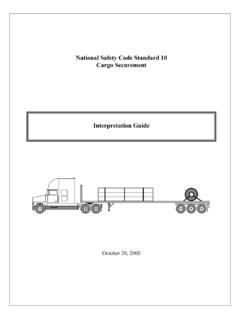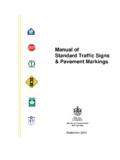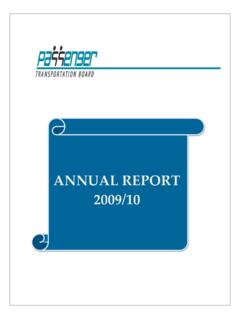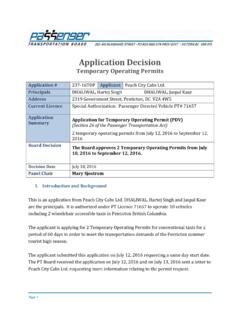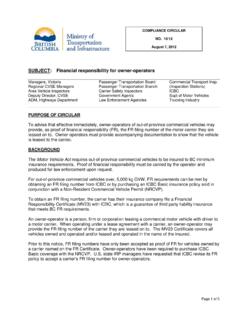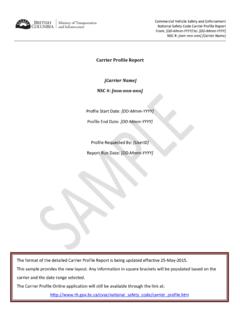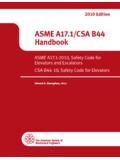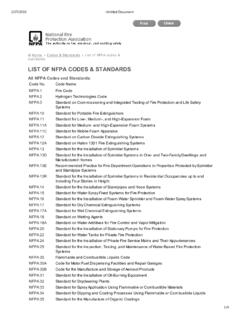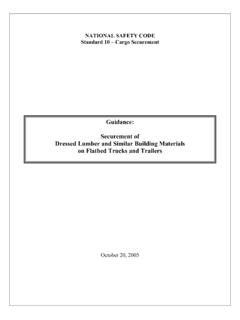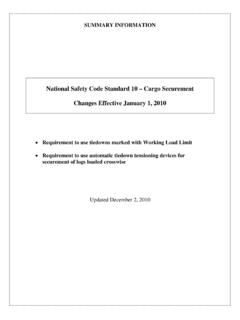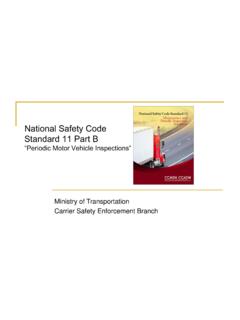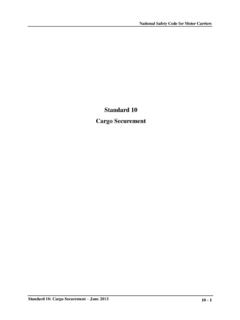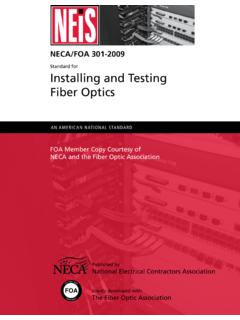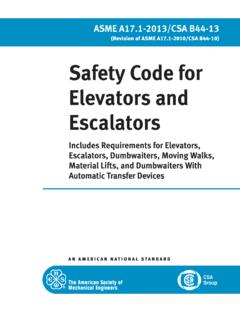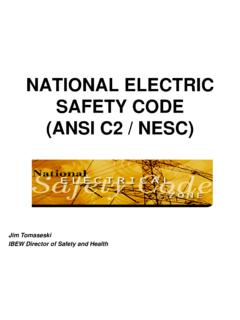Transcription of Amended National Safety Code (NSC) 10 Cargo Securement ...
1 Page 1 of 2 SUBJECT: Amended National Safety code (NSC) 10 Cargo Securement Standard Managers, Victoria Passenger Transportation Board Commercial Transport Insp. Regional CVSE Managers Trucking Industry (Inspection Stations) Area Vehicle Inspectors Carrier Safety Inspectors ICBC Deputy Director, CVSE Government Agents ADM, Highways Department Law Enforcement Agencies PURPOSE OF CIRCULAR: To advise that the National Safety code (NSC) 10 standard on Cargo Securement was Amended by the Canadian Council of Motor Transport Administrators (CCMTA) and approved by all provinces and territories.
2 See These amendments are effective January 1, 2014. The four amendments: 1. Interpretation Section Definitions: Light Vehicle Addresses issues arising from NSC Standard 10 definition which unintentionally causes small equipment ( lawnmowers) and special purpose vehicles ( golf carts) to be considered light vehicles , with unreasonable and unnecessary consequences for loading and Securement when being transported. A change in definition of light vehicle will harmonize requirements with USA, and is supported by CVSA Cargo Securement Public Forum and FMCSA. All Canadian jurisdictions support this proposal. Light vehicles ( automobile, truck or van that weighs 4 500 kilograms or less) are exempt from this standard. However, applicable BC Motor Vehicle Regulations still apply to the transport and Securement of Cargo using light vehicles.
3 2. Division 2 General Performance Criteria: Friction Mats Friction mats are anti-slip devices that are placed under a load on a deck of a truck or trailer and assist in keeping Cargo secure from unnecessary movement. This amendment allows for existing friction mats that do not have a load limit indication marked on them to remain in use until January 2014, as supported by CVSA Cargo Securement Public Forum and FMCSA. The Canadian Trucking Alliance proposed that implementation in January 2014 of this requirement for load limit markings on friction mats is to allow the current inventory of unmarked friction mats to be consumed. All Canadian jurisdictions support this proposal. 3. Division 3 Metal Coils: Rows of Metal Coils with Eyes Crosswise To ensure consistency in both Canada and the USA, this change is proposed to ensure Securement of rows of metal coils with eyes crosswise when loaded on the deck of a truck or trailer as described and provided in current USA legislation.
4 COMPLIANCE CIRCULAR NO. 03/13 August 1, 2013 Page 2 of 2 Securing Coils Transported With Eyes Crosswise on a Vehicle with Anchor Points There are three requirements for coils transported with eyes crosswise: 1. Prevent the coil from rolling. 2. Attach one tiedown forward. 3. Attach one tiedown rearward. One tiedown forward and one tiedown rearward through the eye of the coil at a 45 degree angle. 4. Division 6 Intermodal Containers This change addresses structural designs of different locking devices on containers loaded onto trucks and trailers. It removes the maximum allowable measure of movement ( horizontally in any direction and vertical movement) when securing and locking a container to a truck or trailer. The change now states that the container must be secured and locked onto a truck or trailer. A measurement of container movement is not feasible during an inspection to determine compliance, rather confirming that the container is secure and locked to a container is more appropriate.
5 For information about this circular, please contact Jeffrey Monty, Manager Commercial Transport, at 250-953-4017 or by email at Brian Murray Director, Commercial Vehicle Safety and Enforcement Branch Ministry of Transportation & Infrastructure
